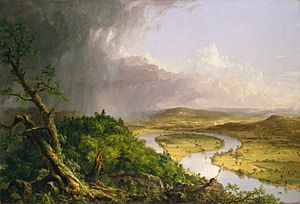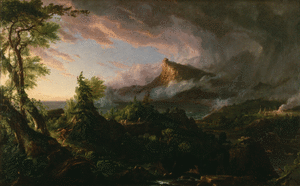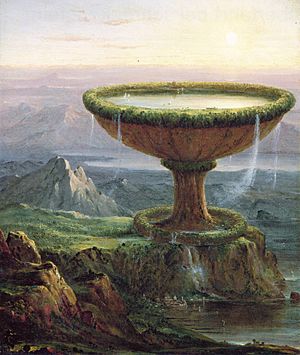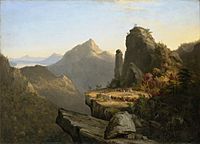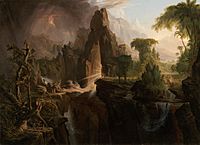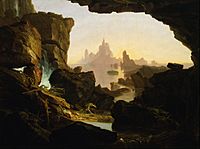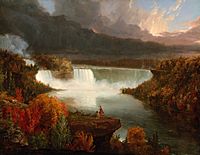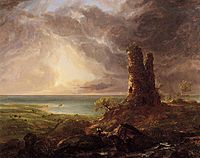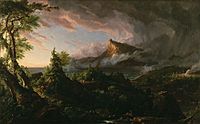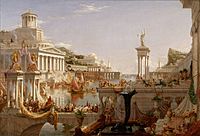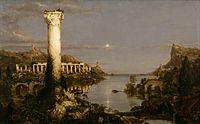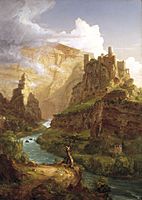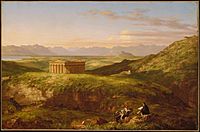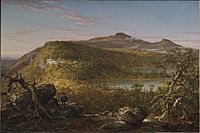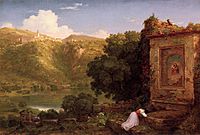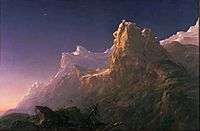Thomas Cole facts for kids
Quick facts for kids
Thomas Cole
|
|
|---|---|
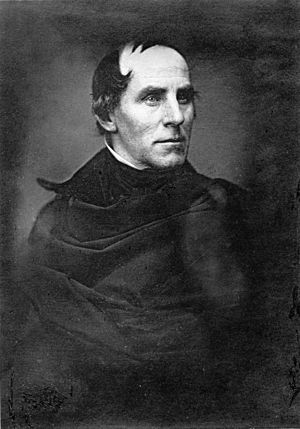
Thomas Cole, 1846
|
|
| Born | February 1, 1801 Bolton le Moors, Lancashire, England
|
| Died | February 11, 1848 (aged 47) Catskill, New York, United States of America
|
| Nationality | English, American |
| Known for | Painting Medium/Media: Oil on Canvas |
|
Notable work
|
The Titan's Goblet (1833), The Course of Empire (1833–36), The Oxbow (1836), The Voyage of Life (1842) |
| Movement | Hudson River School |
Thomas Cole (born February 1, 1801 – died February 11, 1848) was a famous painter. He was born in England but became an American citizen. He is best known for his beautiful landscape paintings. He also painted historical scenes.
Many people see him as the founder of the Hudson River School. This was an art group in America that loved to paint nature. Cole's paintings often showed the wild American outdoors in a very emotional and grand way.
Contents
Early Life
Thomas Cole was born in Bolton le Moors, England, in 1801. When he was 17, in 1818, his family moved to the United States. They settled in Steubenville, Ohio.
Cole started working as an engraver, making designs on metal. He taught himself how to paint by reading books and looking at other artists' work. In 1822, he began painting portraits of people. Later, he started focusing more on painting landscapes.
At age 22, Cole moved to Philadelphia. In 1825, he moved to Catskill, New York. He lived there with his wife and children until he passed away in 1848.
Famous Paintings
When Cole moved to New York, he sold five paintings to a man named George W. Bruen. This money helped Cole travel to the Hudson Valley. There, he painted many landscapes. These included the Catskill Mountain House, Kaaterskill Falls, and Fort Putnam.
When he returned to New York, he showed five of his landscape paintings in a bookstore window. People noticed his work. Important artists like John Trumbull and Asher Brown Durand were very impressed. Trumbull even bought one of Cole's paintings. He also introduced Cole to wealthy friends who became important supporters of his art.
Cole mostly painted landscapes, but he also created paintings that told stories or had deeper meanings. These are called allegorical works.
One of his most famous series is The Course of Empire. This series has five paintings that show the same landscape over a long time. It starts with nature, then shows a powerful empire, and finally its decline and ruin. These paintings are now at the New-York Historical Society.
Another famous series is The Voyage of Life, which has four parts. It shows a person's journey through life. There are two versions of this series. One is at the National Gallery of Art in Washington, D.C. The other is in Utica, New York.
Other well-known paintings by Cole include The Oxbow (1836) and The Garden of Eden (1828). The Garden of Eden shows Adam and Eve in a beautiful, detailed paradise with waterfalls and plants.
Cole's Influence
Thomas Cole had a big impact on other artists in the Hudson River School. Two artists he especially influenced were Asher Brown Durand and Frederic Edwin Church.
Frederic Edwin Church studied with Cole from 1844 to 1846. Cole taught him how to sketch nature and then create a perfect, finished painting. Cole's style can be seen in Church's early works.
Cole also traveled abroad. He visited England and Italy from 1829 to 1832 and again from 1841 to 1842. He wanted to study the style of older, famous artists known as the Old Masters. He also painted the scenery he saw there.
Other Talents
While Cole is best known for his landscape paintings, he had other interests too. In 1836, he wrote an article called "American Scenery." In it, he shared his deep feelings about the American landscape. He saw it as beautiful, emotional, and spiritual.
Cole also made thousands of sketches. These sketches covered many different subjects. More than 2,500 of them can be seen at The Detroit Institute of Arts.
During his trip to Europe in 1842, Cole was very impressed by Mount Etna. This is Europe's tallest active volcano. He found it so beautiful that he made several sketches and at least six paintings of it. One famous painting is A View from Mount Etna from Taormina.
Cole was also a poet and tried his hand at architecture. In 1838, he entered a competition to design the Ohio Statehouse in Columbus, Ohio. His design won third place. Many people believe the final building looks a lot like Cole's ideas.
Personal Life
After 1827, Thomas Cole had a painting studio at a farm called Cedar Grove. This farm was in Catskill, New York. He painted many of his famous works there.
In 1836, he married Maria Bartow, who was the niece of the farm's owner. He then lived at Cedar Grove all year round. Thomas and Maria had five children. Cole's daughter, Emily, became an artist who painted plants with watercolors and on porcelain. Cole's sister, Sarah Cole, was also a landscape painter, and they were very close.
Cole was also good friends with important people in the art world, like Daniel Wadsworth. Letters found in the 1980s show how close their friendship was.
Thomas Cole passed away in Catskill on February 11, 1848, from a lung illness called pleurisy. A mountain in the Catskills, the fourth highest peak, is named Thomas Cole Mountain in his honor. His home, Cedar Grove, is now a National Historic Site and is open to the public.
Selected Works
-
Imaginary scene from The Last of the Mohicans (1827), Wadsworth Atheneum
-
Expulsion from the Garden of Eden (1828), Museum of Fine Arts, Boston
-
Distant View of Niagara Falls (1830), Art Institute of Chicago
-
Romantic Landscape with Ruined Tower (1832–36), Albany Institute of History & Art
-
The Course of Empire: The Savage State (1836), New-York Historical Society
-
The Architect's Dream (1840), Toledo Museum of Art
-
A View of the Two Lakes and Mountain House, Catskill Mountains, Morning (c. 1844), Brooklyn Museum
-
Il Penseroso (1845), Los Angeles County Museum of Art
-
Home in the Woods (1847), Reynolda House Museum of American Art
See also
 In Spanish: Thomas Cole para niños
In Spanish: Thomas Cole para niños


